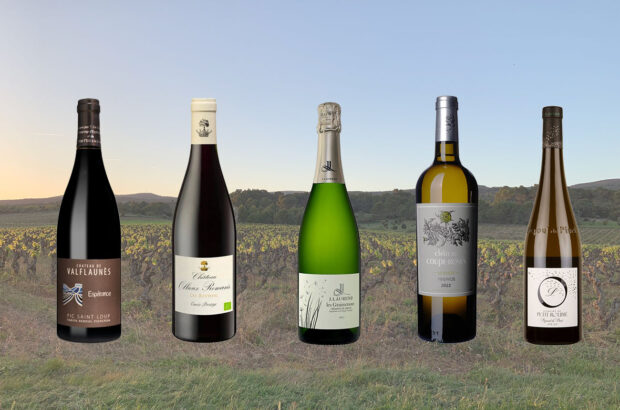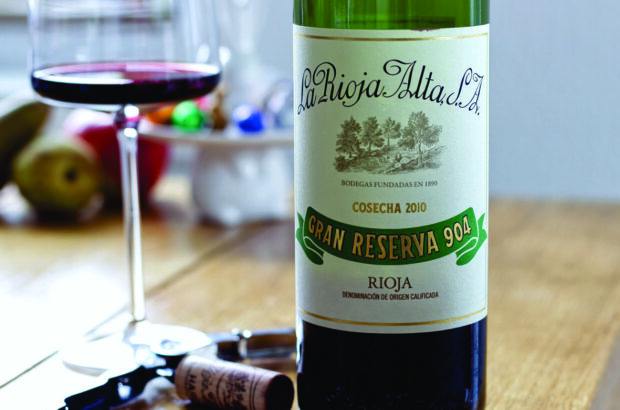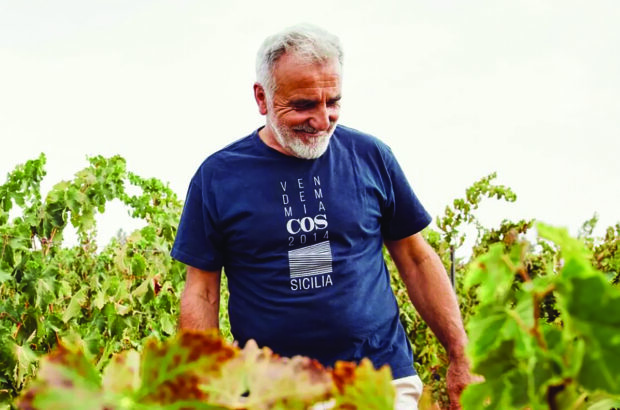Château Angélus
There are three churches in St-Emilion, and when the Angélus bell is rung, it’s said there is just one spot where all three calls to prayer can be heard. The Angélus rings at dawn, midday and sunset. So the label design was a no-brainer. Fortunately, it’s also a strong image that reinforces the identity of the wine. Since it’s unreasonable to expect visitors to stand respectfully in the vineyards at just the right moment, the château has, in recent years, made an elaborate carillon that can ring out dozens of national anthems. The idea has charm – and echoes the bell theme – but if an international group arrives on a winter afternoon, the entrancement can wear thin.

Château Mouton Rothschild
Baron Philippe de Rothschild, always the innovator, came up with the idea of commissioning an artist to design his wine label in 1924, two years after he took over running the estate. At that time, few Bordeaux wines were château-bottled, so labels were not considered that important. The 1924 label featured a Cubist design by Jean Carlu, which must have seemed daring at the time. In 1945,Baron Philippe created a special label to celebrate the end of World War II, the Victory label based on Churchill’s famous ‘V for Victory’ sign. Thereafter, ‘artist labels’, commissioned each year, became the norm at Mouton. (Other wine estates, such as Nittardi in Chianti Classico, have since adopted the same practice.)
The baron was very well connected and was able to recruit such renowned artists as Cocteau, Braque, Dali, Miró, Chagall, and even Picasso. Such labels became a brilliant form of promotion, as wine lovers eagerly awaited the announcement of the selected artist for each vintage. Some bottles even became collectors’ items on the strength of the labels as well as the wine. It was also a bargain for the baron: no money changed hands; instead the artists were compensated with cases of wine.
Following Baron Philippe’s death in 1988, the tradition was continued by his daughter Philippine, and all of the labels are on display at the Mouton museum at the château.

Château Pape Clément
This famous vineyard within the city boundaries of Bordeaux is believed to have been planted in 1252. It was presented to Bertrand de Goth by his brother to celebrate Bertrand’s appointment as archbishop of Bordeaux. When, in 1305, Bertrand was elected pope and took the name Clément V, he donated the vineyard to the archbishops of Bordeaux in perpetuity – a succession that came to an end only with the French Revolution. And that is why the label of this estate displays on its label the papal coat of arms.

Château Balestard la Tonnelle
This 10ha vineyard near the town of St-Emilion is easily identified by its ancient stone observation tower (tonnelle), which probably predates the vineyard. The label is also noteworthy, as it reproduces a poem by the great 15th-century French poet François Villon in which he refers to the estate. Fortunately for the Capdemourlin family, which has owned this and other local properties for generations, Villon chose to rhyme Balestard with divine nectar. It would be hard for any wine estate to produce a more ringing endorsement.

Château Clerc Milon
It’s no surprise that when Philippine de Rothschild was looking for an image to adorn the label of Clerc Milon from 1983 onwards, she raided the superb holdings of Mouton’s Museum of Wine in Art. This silver carving from the early 18th century is from the workshop of German goldsmith Johann Melchior Dinglinger, and depicts two dancers adorned with pearls and diamonds. One of them is clutching a drinking glass, but it’s unclear why the other is brandishing what appears to be a sausage.

Château Cos d’Estournel
The label reproduces an engraving of the winery’s striking façade, with its elaborately carved wooden doors from the sultan’s harem in Zanzibar, and its Chinese-style pagoda – a wonderful sight as you ascend the slope from Lafite to Cos. Louis-Gaspard d’Estournel, who founded the property in the mid-19th century, travelled extensively and used part of his collection of oriental art to adorn the winery. It’s often thought the façade depicted is that of the château, but it is in fact the main entrance to the cellars, as there is no château as such at Cos.
Château Malartic-Lagravière
Like Château Beychevelle, the label of this Pessac-Léognan property features a ship. It alludes to Anne Joseph Hippolyte de Maurès, Comte de Malartic (1730-1800), who bought the château in the 18th century. He was a soldier and then colonial governor of great renown, who successfully took on the English forces at the battle of Quebec in 1756.

Château Léoville Las Cases
The label depicts the splendid, lion-guarded stone gateway that marks the entrance not to a château but to the great vineyards that lie between the road and the estuary. The gate is inscribed with the words ‘Clos Léoville-LasCases’, indicating that what lies behind is a walled vineyard in which the owners take great pride. And so they should, as its immediate neighbour to the north is Latour. The huge Léoville estate was divided up after family squabbles in 1840 and the Las Cases family secured this exceptional site. The location also explains why, in a blind tasting, it is easy to mistake a wine from here for a Pauillac.

Château Calon Ségur
This St-Estèphe property was one of many owned by Nicolas-Alexandre, Marquis de Ségur in the 18th century. Although his holdings included two first-growths-in-waiting, he always had a soft spot for Calon, which he acquired by marriage in 1718, declaring: ‘I make wine at Lafite and Latour, but my heart is at Calon.’ The label pays tribute to this, enclosing the château name within a heart design. The design predates the label, having been installed long ago on the winery wall.

Château Beychevelle
Like many of the top estates of the Médoc, this majestic 18th-century estate lies close to the Gironde river. In the early 17th century it was owned by the Duke of Epernon, a man of great political influence and power who became Admiral of France. The label portrays a sailing ship with a griffin prow, in reference to the story – which may or may not be true – that ships travelling up and down the Gironde were ordered to lower their sails to affirm loyalty to the duke. That may also explain the name of the château, a corruption into Gascon dialect of baisse-voile, or ‘lowered sails’.
Stephen Brook is an awarded author and has been a Decanter contributing editor since 1996













